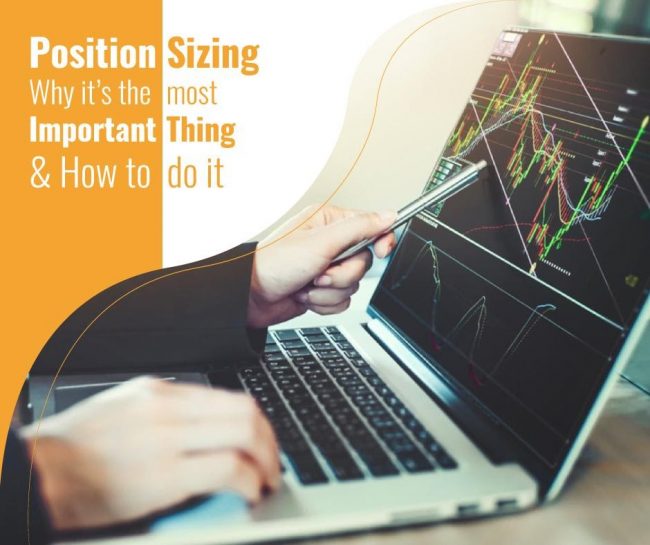Position sizing isn’t everything in trading and investing but it’s darn near close. It’s the key determinant in making sure you have enough size on in your winning trades while reducing your risk on your inevitable losers. It’s a difficult balancing act that typically gets less than a passing thought by most traders and investors. It’s no surprise then that most market participants fail over the long-term.

Position sizing and trade management is a subject that can and should be discussed at length, experimented with, and continuously optimized over one’s trading career. But in this piece, we’ll cover the basics. The essentials, which will give you a good springboard from which to launch your own journey of diving into this deep and rich subject.
All correct position sizing strategies can be classified as anti-martingale. If you’re familiar with casino gambling, then you’ve probably played or seen others play the martingale strategy, which is where one doubles their bet size each time they lose. This is the surest path to the poor house.
Anti-martingale strategies on the other hand, only increase one’s bet size during winning streaks and they’re naturally reduced during losing ones. This ensures you protect your capital while also benefit from the geometric compounding of your capital as you increase it.
The three most popular sizing strategies are below. We’ll run through each one and end with why the third option, is the optimal approach.
- One unit per fixed amount of money
- Equal value units model
- Percent risk model
One unit per fixed amount of money.
Essentially, this approach tells you how much to risk per trade as a single unit per every X dollars you have in your account. An example would be if you have an account of $50,000 and you decide that you will trade 1 share of stock for every $1,000, allowing you to buy up to 50 shares of a company. The problem with this approach should be obvious. Not all stocks are priced the same, nor do they have the same risk characteristics.
This is the method that most new traders/investors fall into because they don’t know any better. This is a simple and intuitive approach with the advantage that you are never limited by position sizing to take a trade you want.

But, there are three big downsides with this approach:
- It prevents you from scaling your sizing rapidly as your account equity grows
- It allows you to take a position with too high of risk
- Not all trades are alike but this position sizing method treats them as such
This is a non-dynamic inflexible position sizing method. It doesn’t adjust for higher conviction, probability, expected value trades. Nor does it account for more volatile/risky instruments. If you run simulations with this strategy, you inevitably end up with an account size of $0. No matter what you’re starting point. You don’t want to use this approach.
Equal value units model.
This strategy is where you determine your bet size by dividing your capital base into equal units. We’ll use 10 in our example, so say you have $100,000 in capital. That would mean that you have 10 units of $10,000 each. You would then use these units to buy $10k of TSLA, $10k of FB, $10k of JNJ, etc…
The benefit of this approach is that it allows you to give each position a relatively equal weight within your portfolio. It also allows you to easily discern how much leverage you have in your portfolio since you can easily add up your positions.
The major downside is that it doesn’t allow you to quickly increase your position sizing as your portfolio grows. Similar to the units per fixed amount, this method is somewhat inflexible and doesn’t optimize or quickly adjust to the size of your equity base. And it also fails to adjust to the position itself, it’s volatility, riskiness, and your conviction level in the trade. To check all those boxes, we have to use the optimal position sizing strategy, which is:
The percent risk model.
The two most important things to know when putting on a trade are (1) your stop, at what price level you will exit the trade if it moves lower than your entry, and (2) how much you will lose if the stop is hit. The percent risk model solves for both. Let me explain.
Let’s say you want to buy the SPY (the S&P 500 ETF). It’s trading at $370 and your analysis suggests that if it falls to $360 then your long thesis is nullified. So $370 is your entry and $360 is your stop. You decide that you want to risk 1% of your account equity on this trade and your account size is $50,000. That means you would buy 50 shares of SPY at $370 and sell them at $360 if the trade moves against you. Your total position size on the trade would be $18,500 which is 27% of your account size. But your risk on the trade is just 1% of your account, or $500. The full equation looks like this:
(Account size) * (Risk Percent) = (Entry Price – Stop Loss Price) * (# of shares)
This strategy optimizes your position sizing for the changing equity in your book. If you consistently risk, say 1% of your equity on trades, then your position size will rise as your account grows (letting you take advantage of geometric compounding) and your sizing will shrink if you hit a losing streak and your account falls.
Furthermore, it allows you to adjust your risk in accordance with the conviction, expectancy, and volatility behind the trade.
There are many variants of this such as the CPR model where you measure risk and reward as R multiples of one another. There’s the percent volatility model where instead of using a user-defined stop, you size your position based on a measure of the underlying volatility of whatever instrument you’re trading. This allows you to size larger in less volatile instruments and smaller in more volatile ones.
Whatever variant you choose, the percent risk model is the optimal way to approach position sizing. Your success as a trader/investor is 80% determined by your sizing of positions and managing of risk, both of which are intricately connected. Finding trade setups and asymmetric ideas are nearly an afterthought if you’re serious about this game. Study and apply the percent risk model and come up with a variant that works best for your system.
